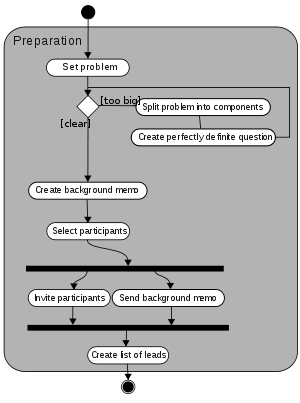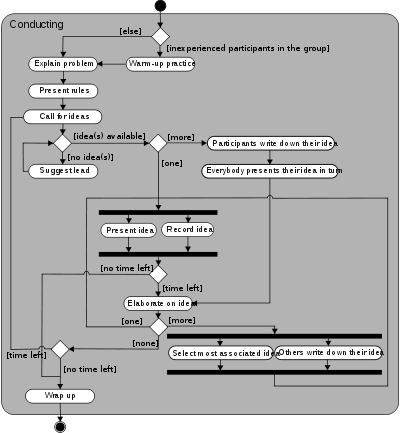Group of creativity methods first popularized by A.F. Osborne in 1941, in which all member of a team are encouraged to generate and share ideas on a specific topic. The aim is to put the participants in the condition of creating original ideas and developing unusual approaches to a problem. Therefore, the group should feel free to express the ideas spontaneous just focusing on quantity, since every evaluation must be postponed later in the process. Following these ground rules in brainstorming can reduce the inhibitions in the group, including self-censorship, and enhance creative thinking:
- Select a specific problem, namely define the problem about which the brainstorming session should focus on. It must be a clear problem and, if too big, it should be broken into smaller parts, each one related to a question. Before the brainstorming session, it may be also useful to send the participants an invitation, containing a description of the problem, so they can start thinking about it;
- Select suitable participants, ideally between six and twelve, as well non-experts as experts. It is important that they have a positive attitude towards brainstorming and an open way of thinking. Each member of the group should participate, since observers can inhibit the creative process;
- Create a positive environment, where each participant can feel comfortable and free. If the members of the group feel judged, they will probably generate less unusual ideas, that often help to the effective solution. Therefore, managers can be discouraged from attending the brainstorming session;
- Select a group moderator, who should be able to conduct the discussion and to enliven it, if the creativity decreases. A list of lead questions may helps the facilitator in accomplishing this duty;
- Aim to generate a large quantity of ideas, according to the assumption that it increases the probability to produce a fit solution to the problem (quantity breeds quality);
- Avoid judgement and criticism, since the negative thinking can demotivate some members of the group to contribute their ideas;
- Combine ideas by a process of association in order to improve them.

Session conduct
To lead a brainstorming session the facilitator usually follows these steps:
- Warm-up, to make the participants feel in a criticism-free environment;
- Presentation of the problem, including also further explanations of it;
- Asking the members of the group for ideas;
- Encouraging the creativity, if necessary;
- Expression of ideas and record of them by someone selected for this duty;
- Elaboration of ideas to make them clear;
- Organizing and clustering ideas;
- Evaluating ideas in order to identify those worthy of action
- Thanking the participants [1]

See also Nominal Group Technique |

